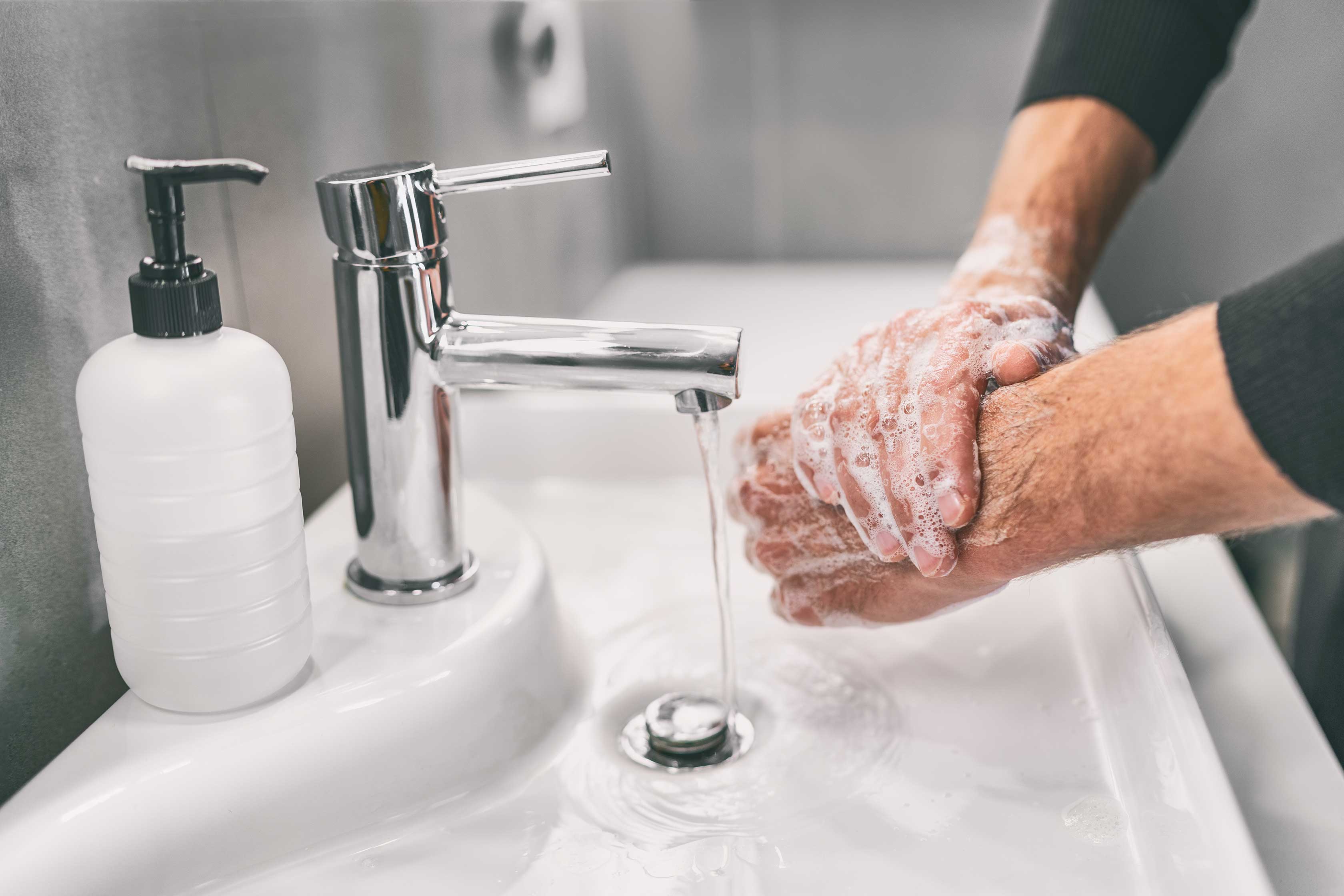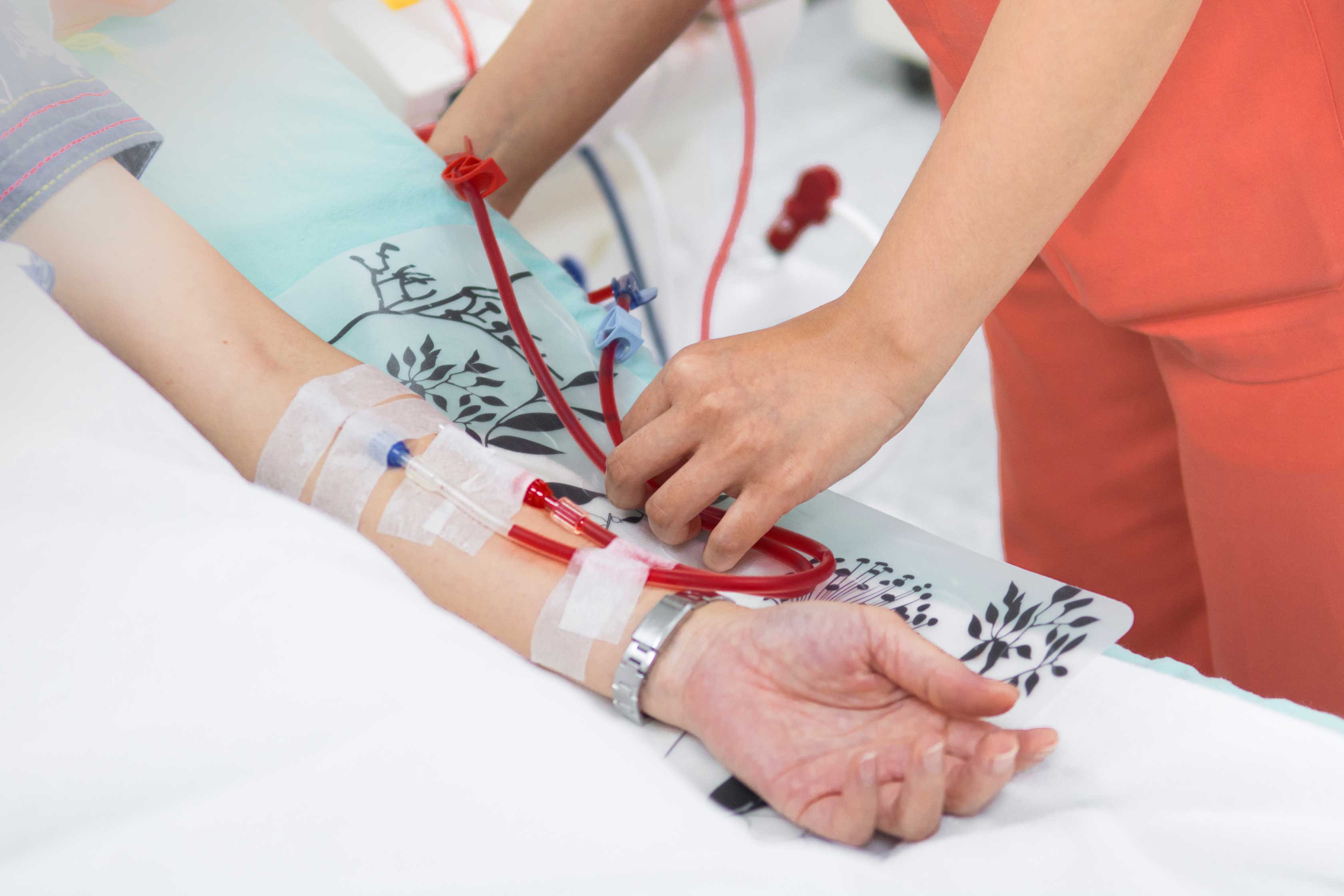Preventing complications

As a dialysis patient, it is important that you perform your vital treatment, dialysis, regularly.
For this reason, you must stay healthy and take good care of your catheter or a fistula / graft, in order to enable your dialysis treatment to last for a long time.
Hygiene measures prevent infections and complications and are therefore of great importance in everyday life.
It is also very important to take your medications as prescribed, even when you are feeling well to avoid complications, and to report any side effects to your physician.
Body hygiene
The skin is the body's natural barrier against microorganisms. This natural barrier is injured when puncturing an arteriovenous fistula or arteriovenous graft. In patients with catheters (either in peritoneal dialysis or hemodialysis), the skin is injured during insertion and there is also a risk later due to improper handling during connecting/disconnecting. Therefore, great importance is dedicated to hygienic / aseptic working practices in home dialysis training.
Asepsic refers to all measures to reduce the number of infectious microorganisms.
Hand washing and disinfection
Hand hygiene aims to reduce the number of infectious agents in order to significantly minimize the risk of infection. There are two techniques for hand hygiene: Hand washing (with soap and water) and hand rubbing (with alcohol-based formulation). Perform one of them always before taking any action related to your treatment, especially:
- Before preparing for treatment
- Before setting up the dialysis machine
- Before puncture

Home environment
In addition to a storage room for the materials required for peritoneal dialysis (e.g., for PD solutions and consumables) and a dialysis room may be required. A closet-sized space is typically needed for supplies. Your clinical staff will talk with you about how to organize your supply storage area. It should have lockable windows and doors.
Particularly important basic hygiene measures during dialysis are:
- Hygienic hand disinfection
- Disinfectant cleaning of all equipment, machines and surfaces near the patient after each treatment
- Removal of pets from the room while performing dialysis
- Asking other people in the room to follow basic hygiene measures as well
- Making sure not to get interrupted, e. g. closing doors
You will learn how to carry out the appropriate surface disinfection of the immediate environment of your treatment, including furniture in your dialysis room, in a detailed training session with your dialysis team.
Vaccinations and avoiding infections
Patients with chronic kidney disease have a higher risk of infections due to their compromised immune system.
Vaccinations can protect you from getting a severe infectious disease by enhancing your body's immune system response by inducing the production of specific antibodies. They are necessary because they help your body find and kill the specific organisms if you encounter the actual disease. Vaccinations are normally completed with just one shot: some require additional shots or repetitions from time to time to produce a sufficient immune response. Vaccinations mean that the risk of people falling ill, and infecting others can be reduced significantly.
Several vaccines are recommended for the general population, with some additional recommendations for patients with chronic kidney disease. Vaccinations for influenza, pneumococcus, hepatitis B and tetanus / diphtheria are especially important.
Your care team will support you in getting your vaccinations and remind you about them if you would like. If possible, please bring your vaccination passport with you when you visit your physician, as you might also receive vaccinations from different physicians.

Peritoneal dialysis (PD) catheter
As with any medical treatment, problems occur related to peritoneal dialysis. However, not everyone may experience complications. We want you to be aware of some of the possible problems related to the peritoneal dialysis treatment that may occur so that you know how you can understand them better. During training, your clinical team will explain in detail what action you have to take if certain problems occur before, during, or after your PD treatment.
If you have a dialysis catheter implanted, ask yourself daily:
- Is the dressing clean and dry?
- Are the clamps and caps closed?
If there are any signs of infection (e.g., redness, swelling, itching, sensitivity, pain, and fever) or you suspect you may be getting an infection, contact your dialysis team immediately.
It is very important that you disinfect and dress the catheter exit site before each dialysis treatment, as directed by your dialysis team. Strictly adhere to the instructions, as provided by the dialysis team, when connecting and disconnecting the dialysis catheter. Also make sure that your catheter is protected as much as possible in everyday life (during personal hygiene, housework, or gardening).
There are three types of infections in peritoneal dialysis:
- Peritonitis: an infection in the peritoneal cavity
- Exit site infection: an infection in the skin around the exit site of your PD catheter
- Tunnel infection: an infection of the catheter pathway under the skin
In most cases, these infections can be solved with the appropriate treatment especially if approached early. However, some infections can be very serious and can result in catheter removal or even having to stop peritoneal dialysis treatment. That is why early recognition and treatment with the proper dose of medication is absolutely necessary. Most of your training involves ways to prevent and recognize these three types of infections.
The primary goal of hygiene measures in PD is to prevent peritonitis, as this may require an interruption of treatment. Peritonitis is caused by organisms entering the abdominal cavity. You can prevent peritonitis by:
- Paying the utmost attention to hygiene
- Following hygiene measures taught by your nurse (this may include wearing a face mask, and practicing regular hand hygiene)
- Changing the bags according to the instructions
Despite all precautions, you may not be able to rule out the possibility of contracting peritonitis. You should contact your dialysis center immediately if you have even the slightest suspicion of an infection.
Always ensure that you work hygienically when changing dressings and bags. This includes:
- Disinfection of the workspace
- Adequate hand hygiene when performing dialysis
- Wearing a face mask
- Not having pets in the PD treatment room
- Regular dressing changes according to instructions by your healthcare team
- Body hygiene
No organisms should get into your catheter extension port. Therefore, the end of the catheter extension must not be touched under any circumstances when the protective cap is removed.
Infection of the catheter exit site or tunnel infection
There are a number of clear signs that indicate an infection of the catheter exit site:
- Redness
- Swelling
- Tension
- Pain, and
- Pus
are symptoms of an infected catheter site. As soon as you notice a change at the catheter exit site, contact your dialysis center immediately.
A tunnel infection is an infection along the catheter tunnel and often occurs together with an infection at the catheter exit site. The tunnel infection may be indicated by swelling, redness, tension, or pain around the catheter tunnel.

HD vascular access
Not everyone will experience complications. Be aware of some possible problems related to the HD treatment that may occur and know how to potentially manage them.
How to prevent complications associated with hemodialysis
As the most important member of your health-care team, you play the key role when it comes to preventing or correcting problems that can lead to long-term and even life-threatening complications.
You can help prevent complications by:
- Taking steps to prevent infection, such as practicing good hygiene at your vascular access site and disinfecting your hemodialysis machine system as advised
- Routinely evaluating the status of your vascular access for signs of infections or any other problems
- Being diligent about your dialysis. Skipping dialysis or not doing it according to your prescription may lead to complications
- Keep in touch with your physician and nurse! Show up at appointments and call in case of question or complication
There are three kinds of vascular access for hemodialysis:
- Arterio-venous fistulae,
- Arterio-venous grafts, and
- Central venous catheters (CVCs)
An AV fistula is usually first created by a surgical procedure in the non-dominant. The connection betweentheartery and thevein ensures that a higher blood flow in the vein is obtained. Due to this, the vein expands, making regular cannulation easier. This is the preferred access for hemodialysis, due to a lower complication rate and better clinical results. The fistula usually takes six to eight weeks to mature before it is ready for cannulation.
If there is any difficulty in creating an AV fistula, an artificial AV graft can be an alternative. This requires connecting the artery and the vein by a synthetic tube implanted under the skin in the arm. In comparison to the AV fistula, it can be already cannulated after two to three weeks; however, complications from blood clotting or infections may occur more often. Nevertheless, grafts can last for several years if they are well looked after.
A CVC is a silicone tube placed into a large blood vessel, usually the jugular vein at the bottom of the neck. This invasive procedure is normally carried out under local anesthesia by a nephrologist. The CVC can be used on a temporary or permanent basis.
Unsuccessful cannulation with AV fistulae and grafts
After an unsuccessful cannulation, a hematoma may appear. A hematoma is a localized collection of blood, usually clotted, in the tissue. Blood may seep into the surrounding tissue, e.g., after an unsuccessful needle placement. If possible, do not place the needle in this area and give the area several days rest until the problem resolves. Do not forget to inform your unit if you are being treated at home!
If your fistula or graft is red, swollen, and/or painful:
- Do not puncture it!
- Inform your dialysis team immediately!
- Keep your arm elevated!
- Cool your arm, e.g., with a cooling compress (make sure that frostbite does not occur).
Any further questions regarding your preparation for dialysis?

